ASUS ZenBook Pro UX550 review: More premium business notebook than gaming machine
Note: This article was first published on 11th November 2017.
A MacBook for PC users
The ASUS ZenBook Pro is something of an outlier in the ZenBook family. While most ZenBooks are svelte ultrabooks or convertibles, the ZenBook Pro is a large, powerful 15.6-inch machine that wants to challenge the MacBook Pro.
But while it may not have the polish of Apple’s premium notebooks, it’s still a rather attractive and well-built laptop, with a solid unibody aluminum design and diamond-cut silver edges. The lid is also etched with the familiar pattern of concentric circles, while the display sports relatively thin bezels – ASUS calls this its NanoEdge display – for a more elegant look.
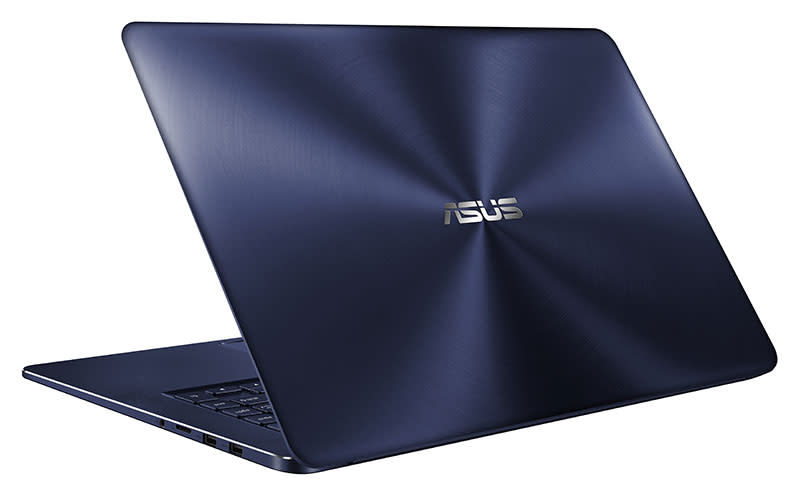
In other words, it’s large but not clunky, quite a far cry from the other NVIDIA GeForce GTX 1050 Ti notebooks we’ve reviewed so far. However, those were mostly entry-level gaming notebooks. While the ZenBook Pro certainly has the chops to run certain e-sports titles such as Overwatch or Dota 2, its appeal lies more in what it brings to the table as a sleek machine for content creators who want slightly more graphics processing power than an integrated GPU can offer.
First announced back at Computex 2017, the new ZenBook Pro UX550 is the successor to the ZenBook Pro UX501. But it’s improved on the latter in almost every way with a slimmer and lighter body, faster hardware, and the same focus on performance and portability. The ZenBook Pro measures just 18.9mm thick and weighs 1.8kg, which also puts it a cut above other GeForce GTX 1050 Ti-equipped notebooks.
The local specifications of the ZenBook Pro UX550VE are as follow:
15.6-inch 1,920 x 1,080-pixel multi-touch IPS display
Intel Core i7-7700HQ (2.8GHz, 6MB L3 cache)
16GB DDR4-2400 RAM
NVIDIA GeForce GTX 1050 Ti 4GB
Samsung PM961 512GB PCIe SSD
365 x 251 x 18.9mm
1.8kg
ASUS has paired that with a generous 73Wh Li-Polymer battery, so the company clearly intends for you to be able to spend some time away from a power outlet.
The ZenBook Pro is a machine for both work and play, and it’d be tough accomplishing the former if the notebook didn’t boast good battery life.
However, at S$2,898, ASUS is charging quite a stiff premium for this particular combination of design, power, mobility. Read on for more on what the notebook has to offer.
A closer look
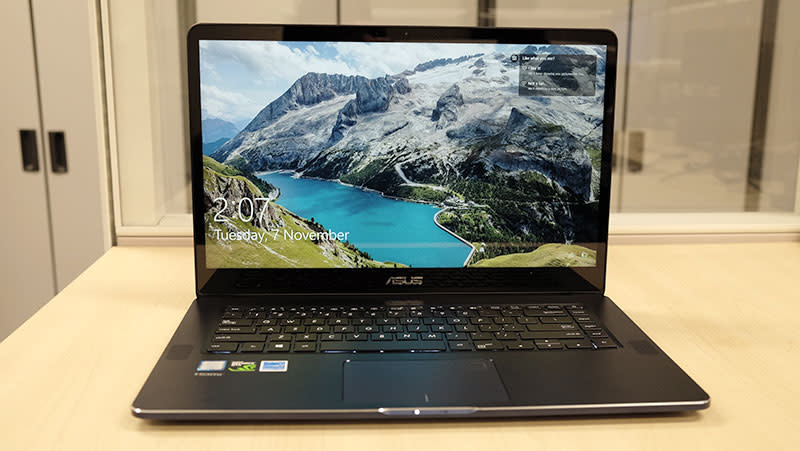
Once you open the lid, the first thing that jumps out at you is the display. The 15.6-inch display is gorgeous, and while ASUS hasn’t quite managed to slim down the bezels to the same extent as the Dell XPS 15, they’re thin enough that they don’t really bother you.
It also means that ASUS hasn’t had to compromise and put the webcam in an awkward position, such as in the bottom bezel.
That aside, having recently reviewed a bunch of gaming laptops equipped with an NVIDIA GeForce GTX 1050 Ti, the same GPU as on the ZenBook Pro, one of my main gripes was how poor the display quality was across the board.
I was met with muted colors, low brightness levels, and poor viewing angles at every turn, so the ZenBook Pro is a welcome change for the better. Of course, ASUS’ laptop is also far more expensive than those entry-level gaming notebooks, but it’s good to see that you’re actually getting something significantly better for the price premium.
The IPS display throws out bright, vibrant colors with good viewing angles, and made everything from walls of crisp, black text to photo galleries quite a pleasure to work with. And while I can’t speak to the accuracy of the color reproduction, most folks should have no issues with it.
However, the laptop does use a glossy panel, so reflections are a problem, especially with bright overhead lighting. This can be mitigated somewhat by increasing the screen brightness, and it’s one of the pitfalls of going with a glossy display over a matte one.
My review unit also comes with a touchscreen display that supports multi-touch inputs, and that can come in quite useful for small things like zooming into photos or scrolling through documents.
Another feature that deserves special mention is the quad-speaker configuration on the ZenBook Pro. The four Harman Kardon speakers pump out loud and full-bodied sound, for a laptop, and bass was tight and punchy.
That’s probably because of the two woofers at the bottom of the notebook, which are focused on handling the low bass frequencies. The top-firing speakers are dedicated to the mid and high frequencies, and the resulting sound quality is definitely a cut above average. When combined with the excellent display, the ZenBook Pro seems set up to be quite a decent entertainment machine.
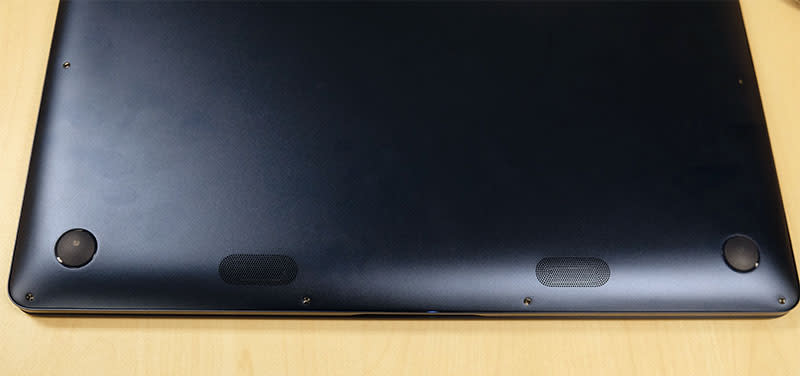
Overall, the unibody aluminum chassis feels extremely solid. Build quality is great, and the display hinge opens smoothly with just the right amount of resistance. Unlike the aforementioned GeForce GTX 1050 Ti gaming laptops, there’s no plastic in the notebook’s body, which is a huge step up.
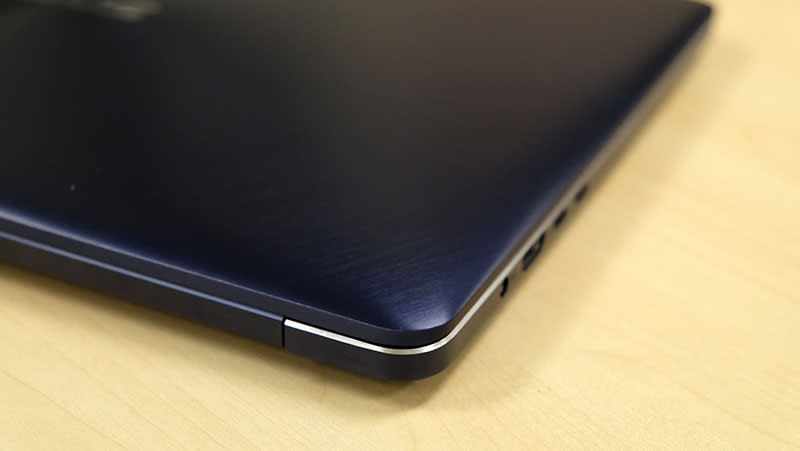
But ASUS also wants you to use the ZenBook Pro for work, so it included a bunch of ports and connectors to facilitate multi-display setups. The laptop supports dual 4K external monitors via two Thunderbolt 3 ports on the left, and you can use them in tandem with the laptop screen for a total of three simultaneous displays.
Alternatively, there’s a full-sized HDMI port available as well for more conventional setups.

There’s also two USB 3.1 (Gen 1) Type-A ports on the right, and a microSD card reader beside them. It’s a little puzzling why ASUS didn’t choose to implement a full-sized SD card reader instead, especially if it’s targeting working professionals with this laptop.
There definitely seems space for one, but now you’ll probably need to take up one of the two USB Type-A ports with a separate card reader if you work frequently with photos. One glaring omission is the dedicated Ethernet jack, which is probably the clearest sign that this isn't intended as a dedicated gaming laptop.

The keyboard itself could also use some improvement, and it feels quite shallow for a laptop of this size. The white backlight is also rather faint, to the point that it’s barely visible in regular indoor lighting. Another minor annoyance is the uneven backlight bleed around the edges of the keys, although you’ll have to be in a dark room to notice that.

Fortunately, the glass-covered trackpad feels responsive and accurate, and it has an integrated fingerprint sensor on the top right corner that will let you log in using Windows Hello. The left- and right-click buttons are also integrated into the trackpad itself, and I prefer this implementation to having separate buttons.
When it comes to cooling, ASUS has gone with dual fans and three heat pipes to draw heat away from the CPU and GPU. Two heat pipes are shared between the CPU and GPU, but the third is located on the other side of the board and is dedicated to helping dissipate heat from the GPU.
The good thing is that the notebook doesn’t get too loud when under load, which is much appreciated given how thin it is.
However, the fans are mostly always active, and there’s a slightly disconcerting lack of intake vents at the bottom of the laptop. Instead, the intake vents are shared with the exhaust, and ASUS says it’s had to rejig the interior layout of the laptop to preserve its thin dimensions. The vents are concealed under the hinge, and it seems to me that this design is a bit problematic because the hinge partially obscures the vents when it’s open.

Nevertheless, the notebook didn’t get excessively warm while I was using it, and temperatures were pretty much on par with the other GeForce GTX 1050 Ti notebooks that actually have plenty of vents. Still, as you’ll see later in the results section, it looks like this design might actually be giving rise to some performance throttling to keep the temperatures in check.
One final thing to note is that the laptop isn't easily upgradeable, which is a bit disappointing for such a performance-oriented system. The bottom panel is held in place by Torx screws, so a regular screwdriver won't work. And even if you do have the right tools to get it off, the RAM actually takes the form of soldered memory chips, so that's not upgradeable either. Your only option is to add more storage in the form of a larger M.2 SSD, although the 512GB drive that the ZenBook Pro comes with should be more than enough for most users.
Test Setup and Performance
We’ll be comparing the ASUS ZenBook Pro UX550 against other notebooks equipped with the same Intel Core i7-7700HQ processor (2.8GHz, 6MB L3 cache) and NVIDIA GeForce GTX 1050 Ti 4GB.
To simplify things, we won’t be using all the notebooks we tested in that shootout. Instead, we’ve picked out the Acer and Gigabyte laptops, both of which also come with 16GB of RAM like the ZenBook Pro, for a more accurate comparison. Finally, the HP Omen 15 has been included as well as it was the overall winner of the shootout.
Here’s a list of the notebooks we’re looking at:
ASUS ZenBook Pro UX550VE
Acer Aspire VX 15
Gigabyte Sabre 15
HP Omen 15
|
|
|
| |
|
|
|
| |
|
|
|
| |
|
|
|
| |
|
|
|
| |
|
|
|
| |
|
|
|
| |
|
|
|
| |
|
|
|
| |
|
|
|
| |
|
|
|
| |
|
|
|
| |
|
|
|
|
All the laptops were put through the following benchmarks:
PCMark 10
3DMark
VRMark
Ashes of the Singularity
Deus Ex: Mankind Divided
Tom Clancy’s The Division
We used the 3DMark Fire Strike Extreme Stress Test for temperature measurements, and the battery life benchmark in PCMark 8 Home to test the battery (PCMark 10 doesn’t yet come with a built-in battery benchmark).
PCMark 10 Extended
PCMark 10 Extended assesses the performance of systems in a variety of workloads, including basic computing tasks, productivity applications, digital content creation, and gaming. Compared to PCMark 8, it also adds in new test metrics, such as app startup times, which quantifies how long it takes to launch a variety of real-world apps, and a rendering and visualization workload to simulate professional graphics and engineering applications. In addition, existing workloads have been updated to reflect modern usage.
Unsurprisingly, the ZenBook Pro performed very similarly to the other test notebooks, given their near identical system specifications. Going by the figures here, there’s no significant difference in performance among the systems when it comes to daily computing tasks.
However, a look at the individual workloads shows the ZenBook Pro lagging behind slightly in gaming tasks, which is something that carries over into the more gaming-oriented benchmarks.


3DMark
3DMark looks explicitly at gaming performance, and it puts systems through a range of graphics and computational performance tests at different resolutions, starting at 1080p and going all the way up to 4K.
The ZenBook Pro was slightly behind the rest of the pack here, coming in at just over 2 per cent slower than the Gigabyte Sabre 15. That’s a small and barely tangible deficit, but it’s still one that persists across the majority of our gaming benchmarks.

VRMark
Futuremark’s VRMark benchmark is designed to assess a PC’s ability to handle high-performance headsets like the HTC Vive and Oculus Rift. If a PC passes the Orange Room test, it is ready for the latter two systems.
The GeForce GTX 1050 Ti isn’t suited to VR, so it’s no surprises that all the laptops fell short of the target frame rate of 109fps. In other words, the ZenBook Pro isn’t going to net you a pleasant VR experience, so you’ll have to look elsewhere if you’re thinking of frequently stepping into other worlds.


Ashes of the Singularity
Ashes of the Singularity is a demanding real-time strategy game that puts thousands of units on screen, and it’s capable of pushing even the most powerful GPUs. However, it’s also rather limited by the CPU at lower resolutions and settings.
The ZenBook Pro continued to trail the other notebooks ever so slightly, and while it isn’t falling behind by a particularly large amount, it’s not a good thing to see either considering that it costs so much more.
Either way, Ashes is beginning to push at the limits of this particular configuration, and you probably won’t want to ramp the settings up to Crazy.

Deus Ex: Mankind Divided
Mankind Divided is one of the most demanding titles to run today, but the good news is that a GeForce GTX 1050 Ti laptop will actually deliver a fairly playable experience, provided you turn the settings down.
Unfortunately, the ZenBook Pro didn’t impress here either, as it continued to fall behind the competition. It’s not like you get a huge performance boost from one of the other laptops, but the fact remains that it isn’t nice to pay more for something and have it perform worse, even if it’s by a marginal amount.

Tom Clancy’s The Division
The Division isn’t as demanding to run as Ashes of the Singularity or Deus Ex: Mankind Divided, but its Snowdrop engine can still stress cards with the use of dynamic lighting and the like.
The same scenario repeats itself here, with the ZenBook Pro trailing the Gigabyte Sabre 15 by nearly 10 per cent at High settings.
Overall, it’s safe to say that gaming performance isn’t its strongest characteristic, and the other GeForce GTX 1050 Ti notebooks are more sensible choices if all you’re looking for is an affordable gaming laptop.

Temperature
The external temperatures of the four quadrants of the notebook were measured after looping the 3DMark Fire Strike Extreme stress test for 15 minutes. This amount of time is more than enough to get an idea of your average maximum running temperature for this workload.
Despite my initial concerns about the design of the cooling system and the vent placements, temperatures on the ZenBook Pro were not markedly higher than the other notebooks.
However, it did fail to pass a 40-loop run of the 3DMark Fire Strike Extreme stress test, which requires a frame rate stability of at least 97 per cent. This tests for how consistent performance is under load, and requires robust cooling, so it seems to suggest that the ZenBook Pro is throttling its performance to keep temperatures in check, which may account for the lower gaming performance observed earlier.

Battery life and power consumption
PCMark 8’s Home benchmark was used to measure battery life on all the systems, which had their keyboard backlighting disabled and displays set at 50 per cent brightness From that result, a power consumption figure was then calculated based on the battery capacity and how long it lasted.
The large 73Wh battery pack on the ZenBook Pro manages to power it to over four hours of use, which is quite an improvement over the Acer and Gigabyte laptops. However, the HP Omen 15 lasted a good 37 minutes longer despite having a slightly smaller battery, which might be due to the higher power consumption of the ZenBook Pro’s IPS display compared to the Omen 15’s TN panel.
The ZenBook Pro’s display also appeared brighter at 50 per cent brightness compared to the Omen 15, so that likely contributed to the higher power consumption as well.


Portability index
Our portability index is an objective measure of how portable a notebook is, taking into account factors like size, weight, and battery life.
Here’s where the ZenBook Pro really shines, thanks to its relatively light weight and slim dimensions. Compared to the other 15.6-inch notebooks, it’s considerably more portable despite not having the longest battery life. This is a 15.6-inch notebook that measures 18.9mm thick and weighs just 1.8kg, whereas other similarly configured models are nearly a full centimeter thicker and weigh up to 2.5kg.
ASUS designed the notebook to be a portable workhorse, and it’s done quite a good job of pulling that off.

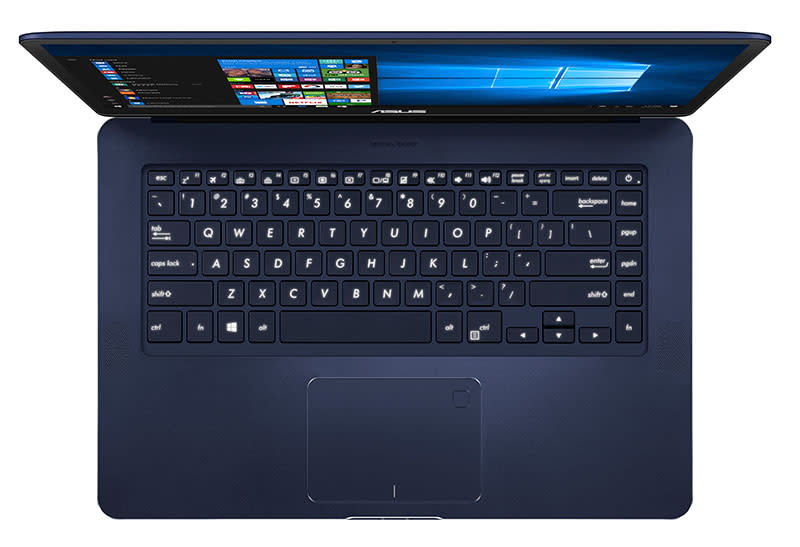
A premium business notebook and a portable workstation for creative professionals
The ASUS ZenBook Pro is a beautiful machine to look at. The rich Royal Blue color of my review unit is a welcome change from the black or gray of so many laptops today, and the excellent display makes a great first impression when you power up the notebook.
The quad-speaker setup also makes it a good entertainment machine that you can take around with you, and I absolutely love how solid the laptop feels when you pick it up. Furthermore, it's a lot slimmer and lighter than other gaming systems with similar specifications, and that's a huge plus point in its favor.
As a workstation system, it supports two 4K external displays via two Thunderbolt 3 ports, all of which goes a long way toward justifying its premium S$2,898 price tag.
After all, its specifications are offered by countless other laptops, and there are better and cheaper gaming systems out there with an NVIDIA GeForce GTX 1060.
Gaming really isn’t the point of the ZenBook Pro, and while you can certainly play games on it, you’re really paying for the design, build quality, and things like the display and speakers. It’s also for those who’d like more screen real estate on their work laptop, and want more than the piddling graphics processing power of an integrated GPU.
Judged on gaming performance alone, the ZenBook Pro would fare poorly, given how it was always slightly behind similarly configured notebooks in our gaming benchmarks. But those notebooks were affordable, mostly plastic constructions targeted at budget gamers.
Conversely, the ZenBook Pro is positioned as a premium option, and the GeForce GTX 1050 Ti isn’t so much an entry-level GPU as a big step up from the integrated graphics normally found on business notebooks.
And while its price may appear high, it’s actually in line with things like the Dell XPS 15, which costs S$3,099 for the same processor, RAM, and storage, but comes with a 4K display. The XPS 15 is also equipped with just a GeForce GTX 1050, so the ZenBook Pro actually has an edge in this area.
One downside is the lack of upgradeable memory and a conservative cooling system, so you’ll have to carefully evaluate your priorities and what you wish to get out of your notebook.
If you’re looking simply for a gaming machine, look elsewhere. But if what you want is a powerful laptop for work, the ZenBook Pro certainly deserves your consideration. And should you really want to play more far more demanding games on it, it’ll also work with the ASUS ROG XG Station 2 external graphics dock.







